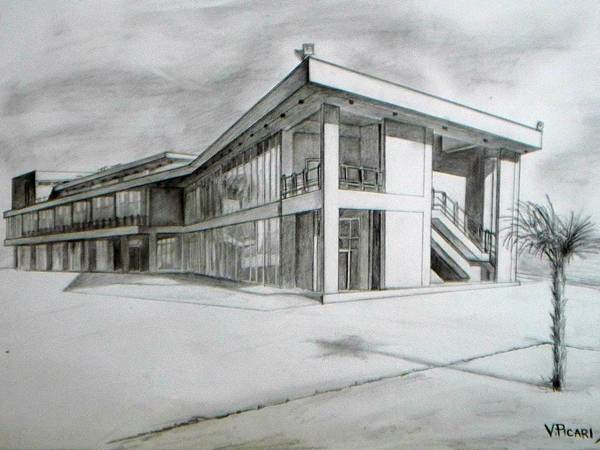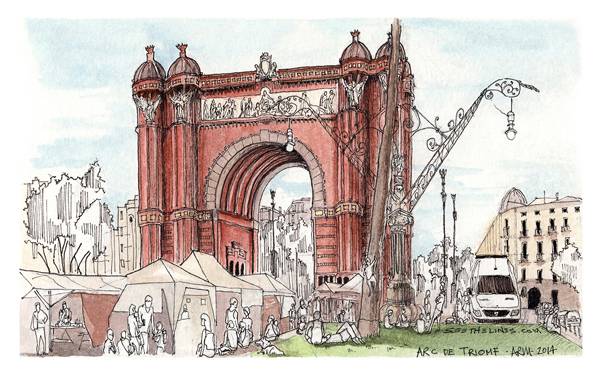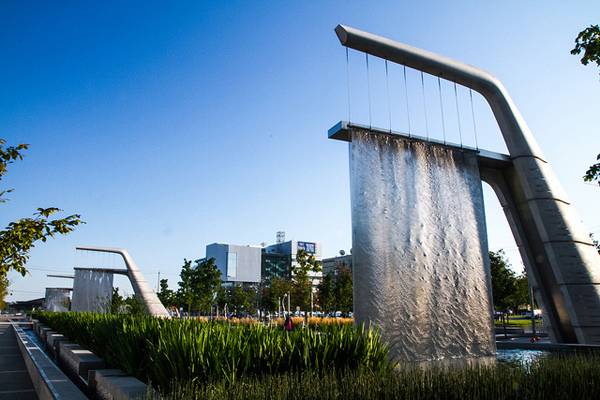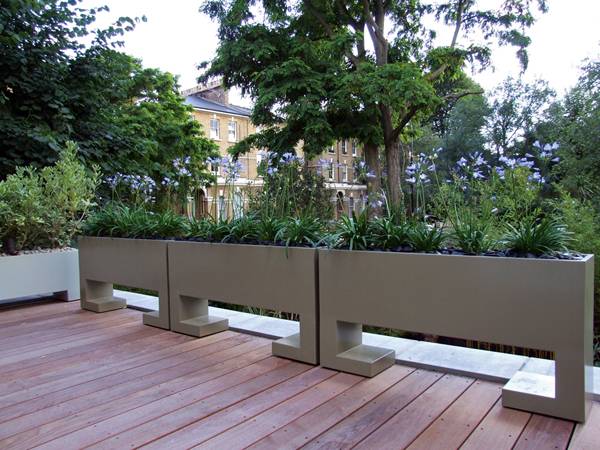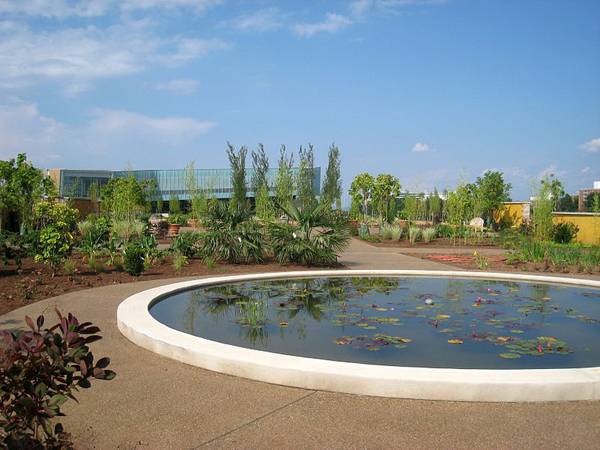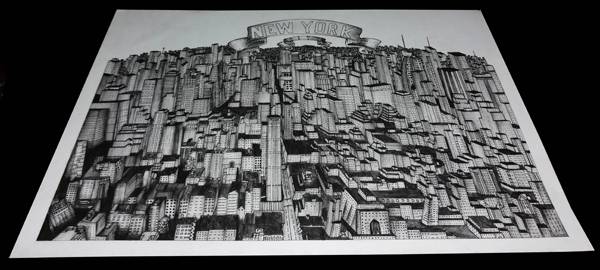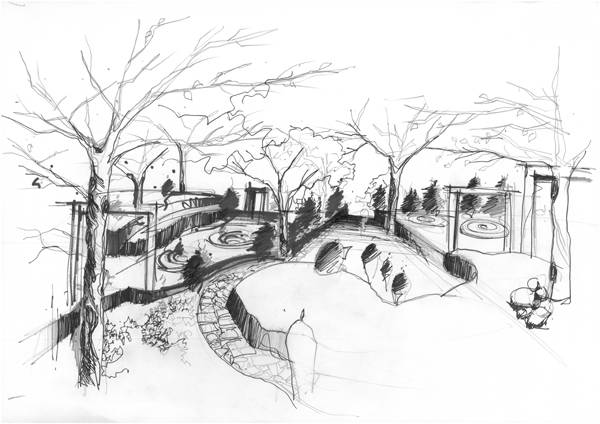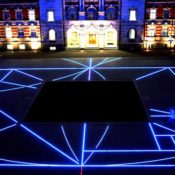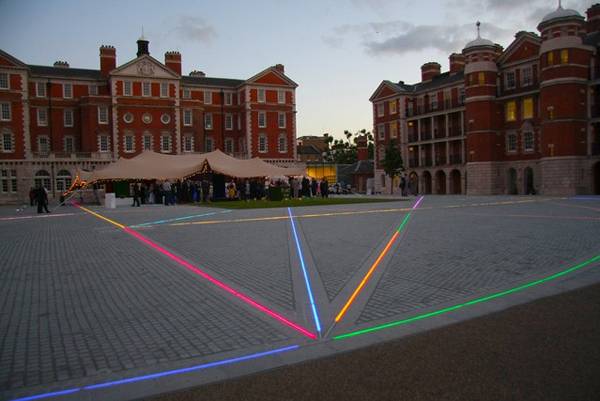Author: Land8: Landscape Architects Network
Green Revival Brings Life Back to River Park
Mill River Park designed by The Olin Studio in collaboration with the Mill River Collaborative. Many people dream of cultivating their own garden after retirement, but the chairman of the not for profit organization Mill River Collaborative (MRC) is turning that into reality but in a much larger scale after he accepted the challenge to implement a world class park in his hometown of Stamford, in New England, US. Arthur Selkowitz had just retired from a successful career in the advertising industry when he was asked to manage the revitalization of the downtown area, crossed by Mill River. According to him, this non paid job has become his full time occupation. Although public investments are funding this improvement for Stamford, the government cannot afford the total cost of such a complex urban operation. The MRC, used marketing tools to find donors and continued the plan, started in the 1990‘s, to recover the natural state of the river and its edges, reshaping the floodplain and creating gathering spaces in downtown.
The first achievement of MRC was the successful campaign to raise funds to hire, in 2005, the recognized firm Olin to work with the US Army Corps of Engineers in the design of the park. The aim was to create public leisure spaces and a trail system along Mill River, linking the central park to other green areas in the city by accessible walkways and cycling pathways. To enable the expansion of the open area in downtown, the public agencies in charge of municipal regulations took measures such as purchasing properties and designating the Mill River Corridor as a new zoning district. When completed, the park will occupy around 28 acres. The first 12-acre section of the Mill River Park and Greenway was opened in the spring of 2013, featuring paths around the river, which had its natural shape restored after the removal of the dam and retaining walls. For years, those constructions had hindered its access in addition to having changed the natural space for the flood flow. The downtown session of the river has become a site with difficult maintenance, characterized by accumulation of wastes. But, since its restoration, the river is flowing freely and native plants are returning on its edges. According to MRC, over 400 trees, thousands of shrubs in addition to a variety of grasses and bulbs are being planted along the river edges and surrounding areas. The aquatic habitat is also being recovered with the use of bio-engineering techniques, which are making possible the removal of contaminated sediments from the river. After the conclusion of this process, fishing and kayaking will be possible leisure options. The community has strongly supported all the implementation stages of the park. From defining the park’s program with the designers to contributing with donations and work, the residents are participating directly in the production of spaces. The playground, the first new improvement in the park, was built in 2006 by volunteers. Now, an area that was used for illicit activities is a verdant place for kids to play. See also: Turenscape Design Outstanding River Park Besides recreational activities, children are having educational benefits: the park is being used by local schools as a laboratory of Ecology. It is also a way for students be introduced to environmental careers through volunteer and paid jobs. These initiatives aim that the young generations become aware of sustainability issues. To keep year-round activities, other facilities are being built with the support of donors: a fountain, a park building and an ice skating rink, planned to be ready for 2015 winter season. Although Stamford central park has the river as main theme, the new grove composed of about 100 cherry trees is its most anticipated attraction. The trees had been long ago planted, aligned to the river, since they were donated to the city after World War II. Some of them were removed and, then, replanted in the new site designed to host a traditional Japanese festival to celebrate the spring. By promoting events and activities according to different seasons, Stamford Mill River Park has given residents the opportunity to reintegrate with Nature. This vibrant green area, joining competent landscape design with advanced bio-engineering techniques, created a balance with the large number of buildings in the center, which resulted in a healthier environment. Not only is this central park improving quality of life but it is also demonstrating an effective combination of public investment, private financial support and community engagement to revitalize the city. Recommended reading: Design with Nature by Ian L. McHarg Sustainable Urbanism: Urban Design With Nature by Douglas Farr Article written by Tania Ramos GianoneSketchy Saturday | 021
This week’s Sketchy Saturday sees some of the regular artists feature along with several new entrants staking their claim to be featured to our rapidly growing Sketchy Saturday weekly feature. We always try to keep the judging process as fair as possible but have to admit with so many styles it is almost impossible to judge everyone with the same criteria, however that’s what I believe makes Sketchy Saturday so interesting, no two sketches are the same and the diversity on display always keeps things spicy. Congratulations to all of you who featured in this weeks Sketchy Saturday top 10, and you are all encouraged to submit more of your work, week in week out, giving your talent the world wide acknowledgment it so truly deserves. 10. Sushmitha.N, a student of 2nd year architecture ,Bangalore,India ww
“A photograph which caught my eyes. The view is a feast to the eyes of the viewer. The stone building blending with the beauty of nature. Its a heritage site in Karnataka,India. As architects, it is our duty to respect and protect nature. Medium and material: This is dry pastel work on cartridge sheet”. 9. Dorjana Kasemi “The sketch was made during the preparation period for a university competition. So we had to move around the city, to go in front of certain buildings in order to learn to draw as needed for a certain time. So therefore we have memorized almost every detail of our city’s facilities. The sketch’s style is a simple technic made with pencil ( different thickness of pencil’s tip ) on normal drawing paper. The building,it is located in the center of the city in Tirana, in front of a park”. 8. by Joshua Rodriguez, United States, New Jersey, Student of the Landscape Architecture Program at Rutgers University “After studying Japanese Gardens this past semester at Rutgers University of New Brunswick, they have become something really meaningful to me and they have become a major part of my design style. I also rendered it in a Japanese style being sure to use ink. The pagoda overlooks a pond that is surrounded by Japanese elements one would see in that style of garden”. 7. Attila Toth, landscape architect, PhD student, SUA Nitra, Slovakia “This sketch depicts the main building of the Slovak University of Agriculture in Nitra built in the 60’s in the Functional style. It is one of the main landmarks of my city and was awarded the “Building of the Century” and listed as a National Cultural Monument, thus it is an inspiring object for sketching. It is a simply sketch made with pencil and coloured with artist pens”. 6. Arch. Roland B. Cepeda Manila,Philippines Vibrant colours really make this sketch bounce right off the page, the rich tones and the old rustic red brick walls create an evening summer time feel; complimented beautifully by the iconic mediterranean styled planting, this picture screams summertime vacation, a good book and a glass of red. 5. Vilma Picari, student in Epoka Univerfrsity, Department of Architecture. “I drew this sketch during the first days of starting studying in this building (which would become my second home). In this way I came to know it better. This is a free hand drawing perspective in pencil of epoka Social Center and Department of Architecture located in Tirana,Albania. I’m a student in Epoka University, Department of Architecture”. 4. Stephanie Kennedy, landscape architect at Walt Disney Imagineering in Glendale, CA “This is a pen and ink drawing of Crown Candy Kitchen in North St Louis, Missouri. My mother grew up in this neighborhood in the 50’s. Although the area has deteriorated considerably since then due to tornado damage, the economy, etc., this is one business that has managed to survive and even thrive. In fact, on weekends, the line to get in usually stretches around the block”. 3. by Mark Sulit Almazan, Architect / Project Engineer (Singapore), Philippines In a tropical country like Philippines, it is very ideal to promote modern open-planning, for its complementary use of architecture and simple decor like glass to create a warm and welcoming place for relaxation and comfort. The interior features simple concrete and from the floor to the ceiling there is folding glass doors, in which natural light flows in. 2. Hayley seolhee Lee, University of New south wales, Sydney, Australia A beautiful overall view of the landscape, taking both manmade and natural features into the scene, blurring the boundaries, not just between materials but between times of construction, style and the every changing economy. 1. Alan Ramiro Manning, Senior Architecture Student at Woodbury University, Burbank, Ca, USA “I sat on a patch of grass at the Arc de Triomf in Barcelona to sketch for the afternoon while enjoying the clamor and bustle of the urban activity. My girlfriend and her friend were taking in some sun beside me, as I passionately observed and delineated the lines that make up this active space.” – That’s it for this week’s Sketchy Saturday, thank you all so much for your weekly artistic contributions that all come together to make Sketchy Saturday what it is – a celebration of talent, creativity and a desire to understand one’s surroundings. Check out the Sketchy Saturday official Facebook album and see literally 1,000′s of incredible sketches! If you want to take part send your entries into us at office@landarchs.com Recommended reading: Sketching from the Imagination: An Insight into Creative Drawing by 3DTotal Article written by Scott D. Renwick5 Great Projects Changing the Way We Look at Landscape Architecture
A designer’s work influences other designers — and this is as true in the landscape architecture community as it is anywhere else. Because noticing creative projects is a key part of finding fresh inspiration, it’s helpful to observe some of the most influential landscape designs in the recent market and see what other designers are seeing. Checking out innovative designs provides new ideas and inspires new ways of creating outdoor spaces. With that in mind, here are a few of the most interesting and inspiring landscape designs currently out there, along with thoughts on why they’re important to landscaping architecture and design. 1. Lincoln Park SoundScape in New World Symphony Campus, Miami Beach, Fla. by West 8
With its trapezoidal pergolas and lacey palms, Lincoln Park Soundscape sets a new precedent for parks in the South Florida area. Despite being small in size (slightly larger than 1 hectare), this site still manages to have a green, park-like feel, while also boasting some one-of-a-kind features like pergolas with shapes inspired by the cumulous clouds common in the region, hand-fabricated and painted aluminum structures to provide shade as well as flower support, and a projection wall at the adjacent Symphony Hall building for featuring the work of video projection artists from New World Symphony. “Open to the public in January 2011, Miami Beach SoundScape Park is a unified expression of recreation, pleasure and culture,” says West 8, the urban design and landscape architecture firm behind the project. “Combined with the momentum of the symphony hall’s uses and outstanding architecture, the New World Symphony campus has become a world-class destination that marries music, design and experience.” 2. Crown Sky Garden, Chicago, Ill. by Mikyoung Kim Design Set within the Children’s Hospital of Chicago, the Crown Sky Garden is a 5,000-square-foot area on the building’s 11th floor, called “a sanctuary for patients, families, doctors and administrators” by World Landscape Architect. It features a restorative healing garden with light, water and vibrant colors. What’s more, the 12th floor has protected treehouse space in order to give kids with health conditions that prevent them from being in the main garden a space to enjoy. The garden won an American Society of Landscape Architects (ASLA) honor award in 2013. 3. Shangri La Botanical Gardens, Orange, Texas by Jeffrey Carbo Landscape Architects
“Demonstration Ponds Shangri La Botanical Gardens and Nature Center” by Shangri La Botanical Gardens and Nature Center
- 10 Incredible Projects For Students To Know About And Why!
- Top 10 World Class Landscape Architecture Projects of 2013
About the author: Jeff Caldwell is the Brand Manager of Superior Shelter in Carrollton, GA. Accepting custom shelter projects from landscape architects and designers globally, Litchfield Landscape Elements designs outdoor shelters, such as pergolas, steel shelters and gazebos, specific to your outdoor architectural project. Return to Homepage
Community Turn Abandoned Industrial Site into Public Park
Community leaders bound together and take on the initiative to turn an old unused industrial site into a thriving public park. Along the banks of the Bronx River, there once was a concrete-mixing plant that operated for more than 40 years. By the mid-1980s, the plant had closed. In the late 1990s, the fate of the site was to be determined at a public auction. Fortunately, visionary community groups, leaders, and partnerships came together to make sure that the site became a public park. With concrete molds everywhere, old factory-like structures occupying much of the real estate, two to three feet of concrete covering the site, and 32,000 tons of soil contaminated with petroleum, it might have been difficult to embrace the land’s potential. But community groups did not give up. A group that would later become the Bronx River Alliance, the Hunts Point Economic Development Corp., community boards, elected officials, Youth Ministries for Peace and Justice, and other groups showed their support through grassroots efforts to clean, protect, and improve the site that would become Concrete Plant Park.

Dramatic before and after of the concrete plant park. Photo credit: (right) Bronx River alliance (left) Joan Byron
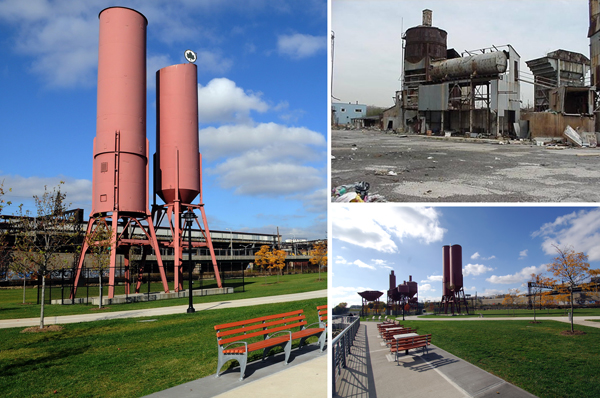
Keeping industrial structures was imperative to the success of the design. Photo credit: Malcolm Pinckney and NYC Parks
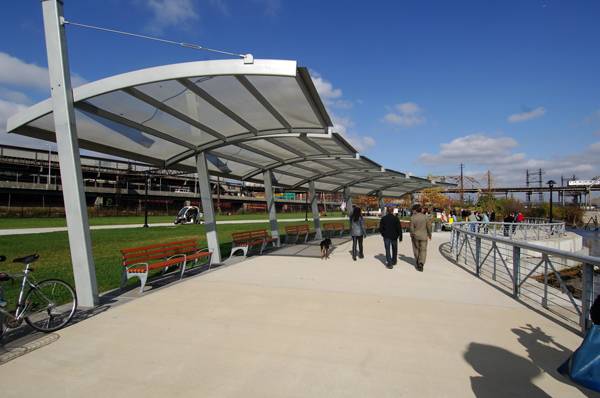
Shade structure and walkway at the Concrete Plant Park. Photo credit: Malcolm Pinckney and NYC Parks
Luxurious Small Urban Garden Getaway
Designer Amir Schlezinger creates a stylish garden at Regent’s Park. When I first arrived to look at the space, the living room had just been extended into the garden by the client, creating an opportunity to connect the two spaces and adding a roof terrace on top. The site was a dark dumping yard, with large surrounding trees overhanging, sloping topography and an ugly fence all around. As the interior was in place when I first visited, I was able to take inspiration from a few key elements that led to quite an instinctive response. The first idea was to recreate the shape of the indoor fireplace with 2 benches featuring a void. The benches are a focal point from the living space and offer ambient lighting. The second feature is the granite waterfall, which is offset to the right side of the garden flowing into two pools. The client was fascinated with water landscapes so this was a key element of the brief. Design logic
The surrounding trees created a subdued atmosphere – I wanted to reflect more light. I selected buff sandstone, which was cut at an unusual size of 900 x 300 mm. This shape further augments linearity within the space, moving the eye across the garden, which is otherwise fairly square. The internal walls would increase radiance with a mellow colour scheme in 4 shades from off-white to fawn, taupe and sable. White silver birch trunks, glass tiles in the water feature, yellow bamboo canes and reflective large foliage would all contribute to an improvement in the quality of luminosity. Planting It was important to provide screening from neighbouring properties so bamboo and palm trees provide evergreen seclusion, while a Strawberry tree and a Snow gum give further architectural evergreen accents. The seating is situated away from the house, giving further privacy with good views of the interior. Whilst the Snow gum Eucalyptus is planted at the top of a raised bed, a different but useful technique was used in the rest of the beds. To eliminate the need for tonnes of earth and to protect the existing fencing behind, the plants emerge from the base of the beds creating a striking light well effect which is valuable day and night. The square space required a few strategies to give a dynamic feel. Diagonal lines are insinuated between the water pool and the bench in the repetition of palm trees from right to left. The simplicity of the planting design therefore provides calm, functional screening and guides the eye across to narrate the space. This simple planting evolves into a lusher and more intricate planting design at the top left of the garden, where curved raised beds meander over three levels. As the garden is also viewed from the upper roof terrace, this contrasting layout offers a dramatic vista. Special features The L-shaped bench provides the main anchoring feature of the garden. Its linearity is contrasted with the upright canes of bamboo, while the yellow tones of both blend when the lighting is switched on, distinguished from the back fence which is painted in a deep aubergine colour. The foliage of a graceful multi-stem Eucalyptus frames the granite water feature, softening the geometry of the structure. The upper pool merges into a lower one creating a sequence of sound and reflection. The granite features two finishes to manipulate the flow of the water, alternating between a smooth honed finish and a textured flamed finish. The stones also increase in size towards the bottom, creating a sequence that stretches out the scale making the waterfall appear larger. To give further depth and dimension the smooth stones are recessed back creating a tactile facade. With the roof terrace enjoying a lot of sun the Mediterranean planting scheme features Olive trees, Agapanthus and Pittosporum. These blend in nicely with the palm trees in the garden – creating a type of South of France oasis favoured by the client. To compliment the bench design in the garden I created a new planter design for the roof terrace. The apertures in the planters mimic the openings in the benches – these allow a view through the master bedroom as one enters the room. The lighting scheme seeks to augment the architectural design of the garden and synchronise the interior with the outdoor space. The garden changes character at night when various zones are remote controlled to provide the required setting. When showing a multi-stemmed tree I usually prefer to up-light it to highlight its form and the texture of the trunks. When working with tall surrounding trees such as here I like to further enhance the space of the garden by projecting into the canopies. When possible, I try to create a moon-light effect by placing the light fittings inside the tree tops where possible. Outlook When the access, space and budget allow using specimen plants, a mature garden can be achieved almost instantly. Being at an end of terrace, it was possible to handle large heavy plants into the space. Having semi-mature plants meant that I could create fully-fledged vistas knowing the client is not likely to stay in the property beyond a few years. Surrounded by large street trees such as Tilia and Robinia the result was a secluded jungly garden, linking in scale to its surroundings, filled with reflection, night time illuminations and two signature architectural pieces that will remain part of the fabric of the residence. Recommended reading: The Contemporary Garden by Phaidon Private Paradise: Contemporary American Gardens by Charlotte M. Frieze Size: 80 sq meters, roof terrace 20sqm, front garden 30sqm Completion: June 2007 Length of build: 4 weeks Cost: $100,000 Location:Regent’s Park, north London, England, UK. See these other designs by Amir: Stunning Contemporary Garden Design! Contemporary Japanese Garden in The English Countryside Floating Roof Garden on the River Thames Article written by Amir SchlezingerIreland’s Biggest Garden Exhibition!
LAN writer Lisa Tierney went to Bloom 2014 to find out what all the fuss was about. This past bank holiday weekend, Dublin’s Phoenix Park hosted the 8th Annual Bloom Festival. It brought huge crowds, and I was lucky enough to experience the elusive Irish summer during the day I attended. It housed beautiful planting schemes with a stunning display of Irish crafts alongside. It was an incredible gathering for plant enthusiasts and an interesting day out for families. The site was filled with show gardens, food, Irish craft stands, and family favorites, all balanced to create an ideal atmosphere.
The gardens were separated into four categories — concepts, large gardens, medium gardens, and small gardens. This gave different types of designers a chance to enter and gave the younger designers an opportunity to create show gardens to be displayed publicly. There was incredible creativity behind the gardens, and the crowds were introduced to comedic, futuristic, philanthropic, and even remedial garden designs, all within one site. Best in Category Winner The winner in the large garden category was Renault ZOE: City Life Garden, designed by Kevin Dennis. This scheme focused on the environment and the benefits plants have on people’s lives. This garden had a stunning palette of purples, rusts, and mid greens that resulted in a contemporary and urban planting scheme. Integrated into the design were a roof garden and green wall within the bright, small seating area. These touches highlighted the urban side of the garden — a reminder to use any space possible when faced with city limits. Within the planting beds were striking steel sculptures and water ponds that added a sense of reflectiveness and serenity once again juxtaposed against the urban lifestyle. I really enjoyed the aesthetics and concept behind this scheme; the planting was well thought out through strong edged paths with overlapping softer vegetation. Below: Renault ZOE: City Life Garden – RTE Bloom 2014 I was really impressed with the integration of plant lovers with the landscape designers and growers as the individual stands throughout the site provided information on anything you could want to know, whether it was Keelings’ Strawberry Way, a growing tunnel filled to the brim with berry plants and lilies, or the show garden’s individual stand workers interacting with the public and explaining ideas and concepts behind the various schemes. I felt the stands breached the gap between designer and public very well and aided interaction between the groups. After spending my day at Bloom, I know I will turn this into an annual visit, as the atmosphere and enthusiasm was unparalleled. As a student, it was impressive to see these gardens that were created with such passion and determination. This is an event that is not to be missed and is an important affair for novice gardeners and more practiced designers alike, giving inspiration to all. You may also be interested in: Top Ten Show Gardens: RHS Chelsea Flower Show 2013 The RHS Chelsea Flower Show 2013 Article written by Lisa Tierney9 Unmissable TED Talks for Landscape Architects
TED has certainly been an inspirational platform for anybody looking for insights into how do we things, live and develop the world around us, delving into psychology, scientific breakthroughs, pioneering thinking and much much more. With so many topics covered TED was bound to touch on landscape architecture related topics, such as cities, biodiversity, social integration and world of design. We’ve filtered through the impressive, stimulating and always intriguing world of TED to bring you 9 Unmissable TED talks for Landscape Architects; of course we don’t expect you to watch all of these TED talks at once, so take our LAN 9 Day TED Challenge and watch one a day for the next 9 days; easy, entertaining and you may even be inspired! 1. Ron Finley: A guerilla gardener in South Central LA “the drive-thrus are killing more people than the drive-bys.” – Ron Finley Ron Finley plants vegetable gardens in South Central LA — in abandoned lots, traffic medians, along the curbs. In this inspiring talk Ron gives us all a reality check and offers us a creative alternative to public interaction within the city landscape. Over 2 million views 2. Marla Spivak: Why Bees Are Disappearing Marla Spivak reveals four reasons for the colossal downturn of the world wide bee population, proposing it as a major problem that must be addressed for the health of us and the planet. Over 1,5 million views 3. The 4 commandments of cities The mayor of Rio de Janeiro Eduardo Paes shares four big ideas about leading Rio— and all cities — into the future, including daring infrastructure upgrades and how to turn the city into a “Smart City”. Over 640K views 4. Erik Schlangen: A “self-healing” asphalt In this short talk Erik gives us a brief yet effective experiment that can lead to a whole generation of self healing roads, with a little help from a heating apparatus. If successful pot holes could become a thing of the past and countless amounts of resources could be redirected for better use. If innovative roads are your thing make sure you check out our hit article Will These Solar Roadways Change The World? Over 800k views 5. Mitchell Joachim: Don’t build your home, grow it! Vibrant speaker, TED Fellow and urban designer Mitchell Joachim shares his vision for sustainable, organic architecture: eco-friendly abodes grown from plants, change the way we think about design. Over 900k views 6. Candy Chang: Before I Die I Want to… This is an emotional video which is sure to pull at your heart strings and by the end of it, you’re going to want to start a similar initiative in your neighborhood. Artist and TED Fellow Candy Chang took abandoned house, created a giant chalkboard on the side of it and posed the thought “Before I die I want to ___.” Her neighbors’ answers — surprising, poignant, funny. This is without doubt a talk we insist that you watch! Over 3.4 million views 7. Kent Larson: Brilliant designs to fit more people in every city With city overcrowding becoming a global problem Kent Larson asks the question “How can we fit more people into cities without overcrowding?” Kent goes on to show off folding cars, quick-change apartments and other innovations that could make the city of the future work a lot like a small village of the past. Over 800k views 8. Edi Rama: Take back your city with paint Could making a city beautiful lessen the possibility of crime and corruption? Edi Rama took this deceptively simple path as mayor of Tirana, Albania, where he instilled pride in his citizens by transforming public spaces with colorful designs. With projects that put the people first, Rama decreased crime — and showed his citizens they could have faith in their leaders. Over 500k views 9. Pam Warhurst: How we can eat our landscapes Pam is certainly an entertaining speaker, very easy to listen to which is important as she has a powerful message to communicate. Asking the question “What should a community do with its unused land?” The obvious answer is simply to plant food! Pam tells the story of how she and a growing team of volunteers came together to turn plots of unused land into communal vegetable gardens, and to change how the community integrate food into their lives. Over 800k views That wraps up our 10 Unmissable TED talks for Landscape Architects, remember don’t try and watch them all at once, take our LAN 9 Day TED Challenge and watch one a day for the next 9 days. If you think there is a relevant TED talk that we’ve missed make sure to let us know! See also: 9 Unmissable Youtube Videos for Landscape Architects Article written by Scott D. Renwick
9 Facts About Landscape Architecture That You Didn’t Know!
Landscape architecture is an amazing profession, covering the design, specification, and management of the built environment, as well as the analysis, preservation, and enhancement of the natural environment. Here we look at nine interesting facts about landscape architecture that you might not know. 1. Origin of Landscape Architecture Many people credit the likes of Capability Brown (1716-1783) and Frederick Law Olmsted (1822-1903) as being the “godfathers” of landscape architecture. But it is in fact a little known Scotsman by the name of Gilbert Laing Meason who first coined the term “landscape architecture” in his little-known 1828 book “Landscape Architecture of the Great Painters of Italy”. Thankfully, this is now available on Google Books, for all to read.

Central Park, designed by one of the earliest known landscape architects Fredrick Law Olmstead. Photo credit: shutterstock.com

LA around the world! Image source, CC 1.0

“Creative Commons Lady Barron Falls Mt Field National Park, Australia. By JJ Harrison, licensed under CC 3.0
Sketchy Saturday | 020
It’s time for another one of our famous Sketchy Saturdays, where we round up all the sketches you send into us and select what we feel are the top 10. We always try to keep it as fair as possible however we are getting to a point now where we have some artists featuring regularly, really cementing their place in the Sketchy Saturday hall of fame! This week we had some really unique styles with a special contribution all the way from Brazil. Enjoy this week’s top 10! 10. by Maria Rochowiak, studying landscape architecture in Agricultural University of Kraków
” I was inspired by my neighbourhood. There is a big forest near by the river Wisła, where there are a lot of ponds. This place is called Nazieleńce and is a protected area. I like very much to take photos and do drawings or even paintings in this place. In the four ground there is a big old tree with amazing branches next to forest road and pond. In the distance you can see the forest”. 9. by André Diogo da Silva “My inspiration was from a great artist, Stephen Wiltshire. I think he is a magnificent artist who overcomes the his autism every single day with his art. He is a great example of overcoming. The location of the drawing is in New York City, one of my favorite places to visit. I didn’t use any style specifically, I just made everything without grids or vanishing points. The materials used were HB, 2B, 4B e 6B, and Nankin”. You can check out André’s Instagram here. 8. by Negar Amini Sometimes a fast sketch is all that is needed to get your point across and this drawing by Negar does exactly that, quickly and effortlessly detailing a landscape that marries both modern design with natural elements, creating movement, style and an entire landscape concept. 7. by Joshua Rodriguez, student of the Landscape Architecture Program at Rutgers University, United States, New Jersey “After studying Japanese Gardens this past semester at Rutgers University of New Brunswick, they have become something really meaningful to me and they have become a major part of my design style. I also rendered it in a Japanese style being sure to use ink. The pagoda overlooks a pond that is surrounded by Japanese elements one would see in that style of garden”. 6. by Dhruva Bangalore With so much going on in this sketch the energy and life in the pond just jumps off the screen, one can certainly imagine, pond skaters, frogs and newts all having a busy day among the plants and beneath the blue sky, taking them all the way into the dusk of night. 5. by Coleene Rich contrasting colours meant this sketch pushed it’s way into our top 10. The strong use of colour makes an otherwise calm setting, daring and adventurous, an exotic getaway perhaps, a secret rendezvous, who knows the artists true intention. 4. by Alan Ramiro Manning, Senior Architecture Student at Woodbury University, Burbank, Ca, USA Alan is one of our regulars at Sketchy Saturday and has an unmistakable style that seems to be geared towards the spaces between spaces, the streets, the alleyways and the laneways, showing a deep appreciation for how things work and not just how they are. “The colors, the materials, the environment all came together to offer this intriguing space in Menton, France. Drawn to the lamp, the exposed wires, and the rusted drain pipe, this vignette delivers quite the transportation effect. Micron pen and Winsor & Newton watercolors used on cold press watercolor paper. My travel sketches can be followed through Instagram, @seethelines.” 3. by Magdalena Subocz, landscape engineer , Poland “This sketch shows the Greek Catholic Church in Wroclaw. Currently, I participate in creating a guidebook advertising the city and the university, hence the decision to execute the sketches of important places. This Greek Catholic Church is one of several made by me using watercolor technique. The Greek Catholic cathedral is located near Wroclaw University, near the Oder River. The Gothic church was built of red brick. This is regarded as one of the most important landmarks of the city. You can check out Magdalena’s blog here. 2. by Giovanna De Lisi, architect Italy “It’s a preliminary sketch for a private garden in Hamburg. the sketch was required to let the client understand the feeling of this “corridor” space (he was not able to understand that from the plan… ) enclosed on one side by the wall with the new material and, on the other side, by a wall made of wood”. 1. by Peter McQuillan Chartered Landscape Architect and artist- working in London “The sketch was done just as a study for a project I’ve set myself – I’m looking to make some paintings to capture the idea of place and the experience of living in the city. So I’ve been looking around and sketching to try and see if I can capture something of the ‘feel’ of things. This is my local high street in London -sketch in watercolour – mostly was done standing on a street corner in everyones way. I’ve always liked this part of the street it’s a real hotchpotch of styles – and it reminds me of many other parts of the world”. – That’s it for this week’s Sketchy Saturday, we at LAN are so appreciative that you are helping to give the artists and their talent the coverage and recognition it deserves, so much talent goes unnoticed and at LAN we aim to put a stop to that. Check out the Sketchy Saturday official Facebook album and see literally 1,000′s of incredible sketches! If you want to take part send your entries into us at office@landarchs.com Recommended reading: Sketching from the Imagination: An Insight into Creative Drawing by 3DTotal Article written by Scott D. RenwickIndustrial Site Transforms into Beautiful Landscape
SWA Group design Sands Bethwork at Bethlehem, Pennsylvania, USA. We have seen how landscape design can create an oasis in the desert and how a temporal landscape installation can promote consciousness about the constant exploitation of the land. Landscape design can also be used in recovery. This type of project, such as the recovery of the Thames River, is responsible not only for the natural recovery of a land mass, river, or mountain, but also can be a catalyst to regenerate societies, economic markets, and social roles. Human activities can be harmful to the Earth; many times we have seen how places once occupied by factories or houses are abandoned and become sites without any living organism. The Sands Bethworks, a project consisting of a new casino, hotel, museum, and mixed-use retail, has been developed in Bethlehem, Pa. The project promoted the recovery of land that was considered a residual place and was affected by previous mineral-mining activity. As the mining economy dwindled, the industry left behind empty and abandoned buildings – as well as contaminants and toxins.
The primary goal of the 20-acre landscape project was the recovery of the natural vegetation and the zone and the conservation of the building as a reminder that every place can be returned to its original status. To do this, SWA Group used a lot of sustainable methods. Existing Problems and Design Solutions The contamination of the soil became the main problem to solve. SWA landscape architects and local authorities found out that the ground of the factory presented high levels of heavy metals and toxic compounds and a serious quantity of petroleum products. Despite the decreasing activity of the mineral industry, the amount of toxic elements were incrementing. The quantity of soil contaminated was around 375 tons, inside the factory site. Another factor to consider is the water pollution that any mineral activity causes. Both problems were considered by the SWA Group as an opportunity to change the conception of parks design. At the Sands Bethwork design project, SWA architects used bioswales that are supposed to intercept runoffs and storm water over 11 acres of land, functioning as natural water purifiers. Another great factor in the Sands Bethwork design is the vegetation’s green palette. After removing all of the contaminated soil from the site, the construction team found out that the soil was also contaminated with highs levels of alkalines, which can cause chlorosis in plants (a process in which leaves produce insufficient chlorophyll and the leaves have a pale or yellow color). Because of this, the selection of specific plants — such as shrubs, trees, and grasses — had to be part of the solution. The new vegetation consists of species that are alkaline-tolerant, such as evergreen plants, and species that can clean up soil through phytoextraction and phytodegradation, like birch and juniper. The importance of respecting the history of the site by maintaining its unique industrial setting was fully recognized by the development team. To unify both new and old site conditions, the design followed the lines of the trestle structures throughout the site, creating order based upon historical precedence. At the entrance of the site, a steel structure is located as a remnant of what was the major activity for almost 100 years in Pennsylvania. Finally, the illumination project is also focused on the factory building, creating a unique night image of what was considered a useless building. The landscape design combines sustainable methods used to recover runoffs and storm water, the plant vegetation palette, and the respectful aesthetic toward the building — all together a good representation of how form and function are always simple but correct. See also: Top 10 Reused Industrial Landscapes Article written by Luis Eduardo Guísar BenítezLighting Scheme Transforms Public Space
The Rootstein Hopkins Parade Ground at Chelsea College of Art and Design Our modern cities desperately need great public spaces, which allow for large public gatherings; encourage people to meet, socializes, and participate in cultural life; and provide space for various public events. The Rootstein Hopkins Parade Ground at Chelsea College of Art and Design in London provides all this and more – a great design that enriches the area and creates a multifunctional, large space so badly needed in any city. Location The Rootstein Hopkins Parade Ground is a 3,500-square-meter square adjacent on three sides to the buildings of Chelsea College of Art and Design and also open onto Atterbury Street. It is special in many ways: It is situated right in the center of London, in the very heart of Westminster, and is very close to important sites, such as Tate Britain and River Thames.
Its location and size make it a perfect space for hosting events, exhibitions, and gatherings, from the final show of London Fashion Week in September 2009 to the Nokia Siemens Networks Roadshow. However, it could never achieve that sort of popularity if it weren’t for its very special design by Planet Earth. This outdoor space’s refurbishment was awarded the Commendation Award in Best Design Under One Hectare category at this year’s Landscape Institute Awards. The project was made possible thanks to the donation of £1.5 million from the Rootstein Hopkins Foundation. The Design Planet Earth designers focused on creating a space that would serve as an outdoor gallery, meeting place, and area suitable for various events. To allow for all those functions, they made it as flexible as possible. The furniture inside the square is kept to minimum, limited only to some simple benches and trees on the perimeter. The interior of the space is broken only by a small square lawn in the middle and recessed light strips adorning the otherwise gray granite paving. The Parade Ground also featured in our hit article Top 10 Imaginative Squares. The Lighting Scheme The LED lights are laid out on the basis of the Fibonacci Spiral, or Golden Spiral, and they change color, creating a very special atmosphere at night. In addition to the LEDs, there are four full-height lighting columns on each corner of the square. The space is fitted with power, water and anchor fixing points, which makes it even more suitable as an outdoor gallery or exhibition area. The Parade Ground also featured in our hit article Top 10 Imaginative Squares. The lighting in this project really shows how a space can be multi layered to the point of creating a whole new space and atmosphere whereby the Parade Ground literally transforms itself from an everyday square to a lit up and exciting hub of activity, showing the psychological impact a lighting scheme has on our minds and senses. Does it work? The design is simple and functional, even minimalist, yet — thanks to the colorful lines of the light strips – unique. Its functionality and its neighbourhood allow it to be used in multiple different ways, which makes it irreplaceable in a crowded, busy city such as London. It must be said, however, that the square looks much better in the evening, when the lights are on, than during the day, when the gray paving and the pale lines of the lights strips make it look a bit like a basketball court. During a rainy day, the space might feel a bit cold and unwelcoming, especially due to its lack of color and its vastness. The advantages of this square definitely outweigh its faults; it succeeds in making this area of London more alive and in engaging the citizens in cultural activities – therefore, it fulfils its goal. It is a great example of the outdoor space designed with functionality in mind. The designers resisted the temptation to add more elements to the interior of the square, which could enhance the aesthetics, but would certainly limit the functionality by cluttering this big, open space. They managed to create the perfect blank canvas for any event one might think of – and this is very rare and definitely deserving of praise! You may also be interested in: Lighting Solutions – World’s tiniest recessed LED luminaire – 1PUCK LP by MINIMIS Article written by Marta RatajszczakInternational Design + Build workshop
International Design + Build workshop creates sustainable natural building for conservation group in Cambodia: A hands-on participatory workshop organised by Building Trust International educates both Cambodians, local NGO workers and international volunteers on sustainable building techniques, working with natural materials and promoting the importance of quality in good design.
Following the construction of several built projects in Cambodia using natural materials and seeing the growing interest and response in sustainable design, Building Trust organised a Design + Build workshop to be held at Phnom Tamao Wildlife Rescue Centre on the outskirts of Phnom Penh with Free the Bears. Working alongside Atelier COLE, a new kiosk design was created which would educate both workshop participants and the 250,000+ Khmer visitors to the park on natural building materials and construction techniques.Free the Bears work tirelessly to combat the illegal trade in live bears and provide a safe sanctuary for any rescued bears at Phnom Tamao. They also aim to educate Khmer visitors on the benefits of renewable energy strategies such as solar power, harvesting rainwater and bio-gas as alternatives to mainstream energy sources. It was important to construct an on site ‘show’ kiosk which not only educates visitors on why conservation is so important but also on how to build with natural materials. Promoting both new and traditional construction techniques to locals with the aim of them using the skills on their own home design in the future. In order to build the kiosk a group of 10 international participants took part in a 2 week long workshop learning about sustainable design, alongside members of the local community and NGO workers.
The design makes use of natural materials such as bamboo for the roof construction and adobe bricks to create the walls. The kiosk quite literally came from the ground it now sits upon, locally sourced bamboo, clay, sand and scrap metal were collected from the site and repurposed into the new building. Matt Hunt, FTB Chief Executive,“Phnom Tamao retains a vast untapped potential to serve as the premier environmental education centre for the nation. Small projects such as this serve as fantastic examples of realistic ways in which Cambodian people can work with sustainably-sourced materials in order to develop their country”. David Cole, Atelier COLE, Partner, “We wanted to create a design which could be built for a fraction of the cost of typical brick/concrete buildings.Using natural building techniques, taught to locals and international volunteers throughout the process, we created a building which acts as a pebble in a pond encouraging more thought about building materials and creating low cost, less damaging alternatives. The rescue centre plan to build more of the kiosks and this project is part of a larger masterplan that we are working on for Building Trust International”. Nev Broadis, FTB, Regional Director,“At Free the Bears, we understand that sustainability and conservation are intrinsically linked. By teaming up with BTI for this project we created a functioning building that doesn’t cost the earth.” Building Trust have developed a set of sustainable toolkits which will be free to download from their website. These toolkits are an educational resource to be referred to when developing natural buildings. Ranging from how to build with adobe, to construction with bamboo, it is hoped that these easy to understand toolkits with photos documenting the process will enable anyone to copy the results. Building Trust are working alongside conservation groups in South East Asia, Africa and South America to not only deliver alternative/ more sustainable buildings but also to use the building process as a tool to introduce new techniques and revitalise traditional skills. Press release courtesy of Building Trust International

















